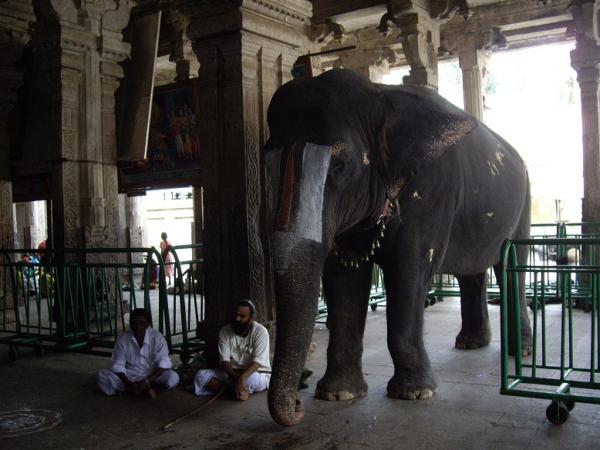Traditions - Temple Elephants

The presence of elephants in temples is a tradition linked to the Hindu and Buddhist religion and occurs mainly in India and Sri Lanka. These animals live in captivity and are used in ceremonies and festivals as a symbol of fortune and good luck. Although their presence is not directly linked to the tourism industry, many foreign visitors often come to these temples because of the cultural attraction in which this cruel tradition is disguised. In the city of Kerala alone, in the south of India, there are about 600 elephants used for this purpose.
Elephants’ lives in temples are full of stress, boredom, loneliness. They are chained by their legs, sometimes by a front and a back one which prevents them from even turning around. This severe movement limitation for long periods of time does not contemplate any well-being measure, causing frustration, physical pain and deep psychological suffering. As a result, these elephants exhibit stereotypical behaviors such as constant rocking of the head up and down or of the body from side to side. These are unhealthy behaviors and not a "dance" as some of their responsible often justify. Over time, the chains can cause cuts, wounds or serious infections that can cost them their lives.
Physical consequences
The temples are not equipped with adequate facilities for the care of an elephant which can meet the animals’ basic needs. For example, a wild elephant spends 18 hours a day looking for food and can drink up to 200 liters of water. During the hottest hours of the day, a wild elephant will seek shade to keep cool and spread dirt on its skin to protect it from the hot sun. They spend much time in the water to cool their bodies, soften their skin and take mud baths. In a temple, the lack of shade and access to water can cause them skin irritation, discomfort and sunburn.
These same elephants are made to participate in religious processions, crowded festivities that can last for several days and during which the animals are deprived of rest. Surrounded by lights, people and noise, these processions can be very stressful for the animals. During the festival season, elephants move from one procession to another and at the end of the season, many of the elephants are very weak, malnourished, dehydrated, aggressive, and sick.
Consequences on their natural behavior
Elephants are highly social animals, females and young live together in herds and calves spend time playing. The elephants in temples are isolated and in cases where there is more than one, they are deprived of contact with others.
The Pajaan: breaking the elephants' souls
And how do you "tame" the elephants that live in the temples? The Pajaan is a practice of "training" or wrongly called "domestication" whose purpose is to "break the soul" of the animals so that they become submissive beings totally incapable of disobeying human orders. This is accomplished by separating the young elephants from their mothers (something that is already very traumatic for these animals).
To subdue their will, they are usually deprived of food and water. All social contact or movement is limited by locking them in cages or chaining them, depriving them of sleep and rest, and repeatedly hitting them with metal hooks in sensitive places such as their ears and eyes. The more the animal tries to rebel, the more he is hit. These animals will never be able to forget this violence and after the Pajaan, they will always be afraid of men. It is this fear, not the false domestication, that allows them to be controlled and dominated.
The documentary Gods in Shackles details the life of these animals in the temples of Kerala and shows the cruelty of this tradition.
